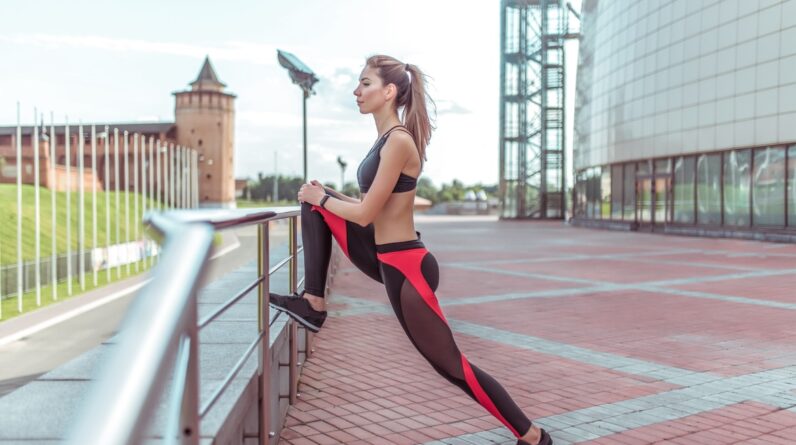
You have the best intentions when you work out—to feel energized, be healthy, and tone your muscles. But as great as your go-to workouts like cycling or lunges might be, they could be tightening your hip muscles.
There are a few key reasons you want to avoid tightness in that area. Usually, tight hip muscles involve the hip flexors, a group of muscles at the front of your hip that help move your legs, per The Hospital of Central Connecticut. These muscles also connect through your abdominal cavity and lumbar spine, which is why chronic hip tightness is often linked with low back pain.
Although a common culprit of hip tightness is sitting too long (ahem, desk jobs and long-haul travel), certain workouts can also cause tight hips.
“As a physical therapist, I often see clients who experience tight hip muscles from common exercises,” says Steven Cheung, PT, DPT, lead physical therapist and founder of Synaptic Rehabilitation. “While these exercises are excellent for building strength, improper form or excessive repetition can lead to hip tightness.”
Plus, the act of strengthening the muscles itself can lead to hip tightness.
“When muscles get stronger, they tend to become tight or overactive,” says Steve Stonehouse, CPT, vice president of programming and education at BFT.
Common exercises that can cause tight hips include:
- Squats
- Lunges
- Leg Presses
- Leg Raises
- Cycling
Regular gym-goers or athletes, people with overweight or obesity, and those who sit for long periods of time are most prone to tight hips.
Beyond the potential pain and strain you may experience from tight hips, it’s important to address tight hips so they don’t affect the rest of your workout.
“Exercising on top of tight hips reinforces bad patterns that can affect your gait and efficiency of movement,” says Kyle Krupa, DPT, CSCS, founder of KRU PT + Performance Lab and a physical therapist who has treated and trained Olympic gold medalists, among other athletes.
In This Article
-
01
Exercises That Cause Tight Hips
-
02
Prevent and Treat Tight Hips
Exercises that can cause tight hips—and how to adjust them
Proper form during certain exercises can also help keep your hips flexible. Here are Dr. Cheung’s top tips for correctly doing these five exercises that can cause hip tightness.
1. Squats
When you perform a squat, maintain a neutral spine and ensure your knees track over your toes (avoid letting them cave inward). Engage your glutes and hamstrings to distribute the workload evenly.
To avoid muscle overuse, stick to three sets of 10 to 15 reps, two to three times per week.
2. Lunges
Keep your front knee directly above your ankle and your back knee pointing toward the ground when you do a lunge. Engage your core to stay balanced and avoid leaning forward.
To avoid muscle overuse, stick to three sets of 10 to 15 reps, two to three times per week.
3. Leg presses
Position your feet shoulder-width apart and press through your heels as you complete your leg presses. Ensure your lower back remains in contact with the machine seat to avoid excessive lumbar extension.
To avoid muscle overuse, stick to three sets of eight to 12 reps, two times per week.
4. Leg raises
Engage your core and avoid swinging your legs. Aim for slow, controlled movements to fully activate your hip flexors without straining them.
To avoid muscle overuse, stick to three sets of 8 to 12 reps, two times per week.
5. Cycling
Adjust your bike seat to an appropriate height so that your knee remains slightly bent at the bottom of each pedal stroke.
Vary your cycling intensity and duration to prevent overuse. Stick to a 20 to 30-minute session two to three times per week.
“Exercising on top of tight hips reinforces bad patterns that can affect your gait and efficiency of movement.” —Kyle Krupa, DPT, CSCS
How to prevent and treat tight hips
1. Start stretching more regularly
Although stretching after workouts can be a good preventive measure for tight hips, it’s key to stretch before your workout if you’re dealing with tight and painful hips already.
“You should not wait until after a workout to stretch in that case, as it may cause you to build tightness on top of tight and dysfunctional hips,” Dr. Krupa says.
Stretches that may help you soothe tight hips include:
- Couch stretch: This is a kneeling position that pushes the hips forward to stretch the quads and hip flexors. Here’s how to do it.
- Hip 90-90 stretch: This is sitting position with one leg bent in front of you and the other bent behind to open your hips. Here’s how to do it.
- Banded hip mobilization: These are dynamic movements usually done with a resistance band around the hip to boost hip mobility. Here are a few examples.
“Stretching under higher temperatures, like in a sauna, can also help you hit deeper stretches with less pain,” Dr. Krupa says.
2. Avoid overusing the muscles
It’s been said that there’s no such thing as over-training, only under-recovery. Make sure you’re building in rest days to keep your hips limber.
“I wouldn’t program more than two to three days per week of heavy strength training or high-intensity work,” Stonehouse says. “One to two additional days could be okay as long as the overall intensity is low.”
Switching up the amount you lift and the reps can also help prevent tightness.
“You can vary the stimulus to avoid overuse with strengthening exercises,” Dr. Krupa says. “For example, do one heavy day with fewer reps and one lighter day with more reps.”
3. Properly warm up your hips
If you’re jumping straight into your workout, it could be shocking your hips into a tightened state.
“A common mistake that causes tight hips is not properly warming up the hips to move through the full range of motion or to accept heavy weight loading,” Dr. Krupa says.
Try these quick hip mobility exercises to loosen up in five minutes before your workout.
4. Move throughout the day
The more you sit, the more you put yourself at risk for tight hips. That’s because sitting puts your hip flexors in their shortest position and decreases blood flow to these muscles, per Specialists in Sports and Orthopedic Rehabilitation.
Sitting for long periods of time can weaken your core muscles and glutes, causing your pelvis to tilt forward—which can also cause hip stiffness.
“There’s a clear link between people having some type of sedentary occupation and experiencing low back pain,” Stonehouse says. “This sedentary occupation creates what we call lower body cross syndrome.”
With lower body cross syndrome, your abs and glutes become long and weak, while the low back muscles become short and tight, per the Hospital for Special Surgery. As a result, you may experience low back pain and tight, less mobile hips.
5. Practice proper knee alignment
Practices like tai chi focus on flexibility in the “Kua”—the pelvis area that includes your hips, groin, glutes, upper thighs, and lower abs—by ensuring proper knee alignment.
“In Chinese anatomy, the Kua is one of the most important areas that needs to be supple to support your body’s mobility,” says Shirley Chock, CCWS, owner of Aiping Tai Chi in Milford, Connecticut.
Here’s a simple tai chi alignment exercise you can practice to achieve a more flexible hip region:
- Stand with your feet shoulder-width apart.
- Imagine your leg is attached to your hip with a long screwdriver.
- Observe the direction your knee and your toes aim, then visualize screwing the screwdriver until the knee and toes are pointing to the same direction. Your hips and groin will activate and you’ll feel a deep internal stretch.
- Repeat on the other side.
“Strengthening and stretching the Kua to promote proper knee tracking alignment is an important first step for more flexibility,” Chock says.







